#for context I was thinking about how almost any latine artist is problematic and on the edge of cancellation baded on usa online standards
Text
As someone from Latam, the way the people of United States views racism and discrimination is so unique to their country it scares me how easy it is for them to try and apply it for everything.
It's kinda impossible for me to imagine discarding everything that is flawed within Latine culture in an attempt to erase racism and discrimination. Because there are many elements that are vital to the Latine culture that are both incredibly racist and incredibly representing. There's not a neat cut on something "good" or "bad", not a set of rules that can tell you what you should engage with.
That's what critical thinking is for?????
Idk. It's the way I've read some people screaming for more diversity in their favorite shows and then when the art doesn't match their cultural frame, instead of researching or trying to understand why it is different in the first place?!?! They go out accusing and judging and setting trials based only on what they know.
Maybe the reason they don't give you as much cultural diversity as you want is because you can't take it without the threat of becoming a puritan, you know... Like, it's okay to lack the tools to analyze something, we all ignore a lot, that's the basis of the human condition. Just chill and try to ask and investigate for once in your life...
#for context I was thinking about how almost any latine artist is problematic and on the edge of cancellation baded on usa online standards#and I'm glad most of usa have access to a very limited range of latine artists because what the fuck#worst part is that the usa online way of thinking is becoming the standard for a lot of teens in Latam it's a freaking nightmare sometimes#how is that they can't tolerate to know a person can do both good and bad and it must coexist#curate your own experience all you want but be careful on narrowing your view of the world so much you end up becoming you swore you hated
3 notes
·
View notes
Text
Rio de Janeiro, Brazil - Week 1
The bus ride from Paraty to Rio was easy and uneventful. The road runs along the coast, but unfortunately the view is mostly obscured by overgrowth. I caught some dramatic, beautiful glimpses, but Brazil could learn from California and Australia. Upon arrival at my Ipanema AirBnB, I took a breath then settled in for two weeks of adventure....
My friends Scott and Tony had left Paraty a couple days early to come to Rio, so I met them for drinks and dinner Saturday night. We walked to a lively, popular-with-millenials section of Leblon and ate dinner at CT Boucherie, an established steakhouse-ish restaurant that was fantastic (and a great value for how much we ate and drink). Those guys had had a big night on Friday so we all turned in early.
And it’s good we did since Scott had a full day planned for us. We started at Parque Lage for breakfast at their famous restaurant. It occupies the courtyard of a crumbling mansion (now an art school) and sits just below Rio’s most famous landmark, Christ the Redeemer. It’s a setting made for Instagram, and everyone certainly took advantage of that. The food was pretty tasty for a place that could easily half-ass it. After breakfast we walked around the park a bit and saw our first monkeys!
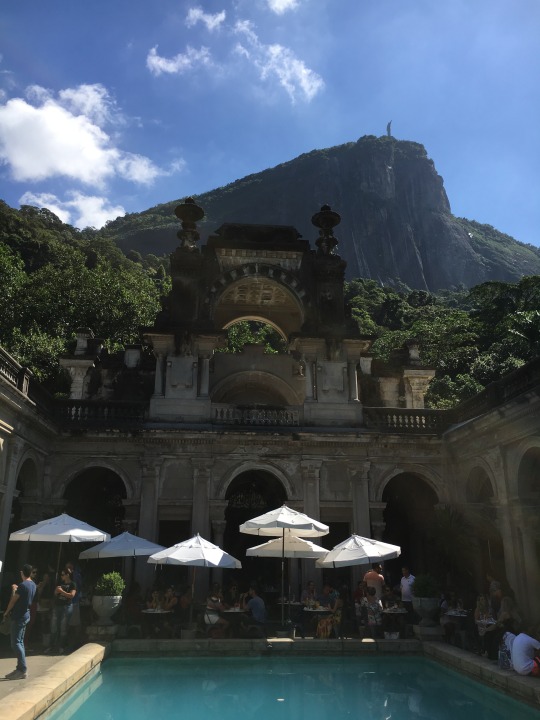

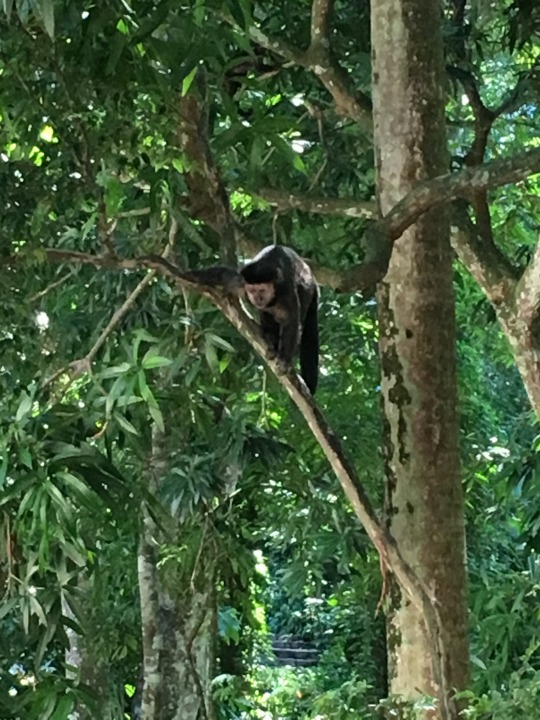
We then walked through Jardim Botanico, which appears to be the Beverly Hills of Rio. We walked through the Botanical Gardens as well, which are lush and beautiful. I think the most striking element were the massive tree trunks, some of which formed walls rising several feet above the ground.
From here we traveled back to Ipanema’s Praca General Osorio for the famous “Hippie Fair”, an arts and crafts market. I’m not sure what the big deal is-- it seems like every other crafts market I’ve seen. Afterwards the guys went to the beach, but I needed some literal chill time in front of a fan, so I lay low at my apartment for a while. We met up again for dinner at Zaza, a delicious Moroccan restaurant. It was the guys’ last night, but we were all pretty beat, so we called it early after a couple more beers.
Monday was shopping day, both clothes and groceries. I am not a beach person, and I was not prepared for how beached out Rio is. Even at nighttime in nice restaurants, people are in t-shirts, shorts and flip-flops. I needed some more beach wear to fit in (tho I only ended up finding one pair of shorts I liked). I met up with the guys again for lunch at Barraca do Uruguai, the most famous stand at Ipanema beach selling delicious meaty sandwiches. They had to get to the airport so we parted ways and I found myself all alone in Brazil....
On Tuesday I committed to the hard work of tourism. In the morning I took the metro to Centro, the historic center of Rio. I emerged at Rua Uruguaina into a hectic street bazaar. It was initially unnerving but a nice break from laid back Ipanema. Once I got my bearings I climbed up to Morro de Conceicao, a very old, Lisbon-esque street with cute (if shabby) townhouses, and then down to Praca Maua, the waterfront area that was revitalized for the 2016 Olympics. I first visited the Museu de Arte do Rio, housed in a beautiful colonial building attached to a gleaming modern annex. The view over Guanabara Bay is fantastic. The museum was showing two exhibits, one (”Mulheres”) featured women artists and had a lot of compelling pieces. The other was a history of samba. Once again I couldn’t understand the Portuguese captions, but there was enough music, video and glamorous visuals to make it fun nonetheless.

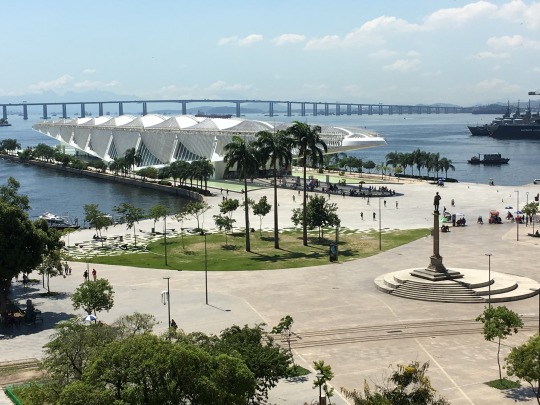
I walked across the plaza to Museu do Amanha (”Tomorrow”), a very modern “science” museum with a lot of interactive video displays and flashy installations for these selfie/social media loving Brazilians. The science was a bit thin; it starts with a brief history of the universe then focuses on humanity’s impact on the planet, for better and worse. But it was engaging.


I then hiked up another hill to the Mosteiro do Sao Bento, a monastery that is one of the city’s oldest buildings. Its plain, humble exterior belies an over-the-top opulence inside, a theme I found in every church I saw that day. Those early Portuguese settlers loved ornate, gilded wall reliefs like you would expect from Louis XIV.

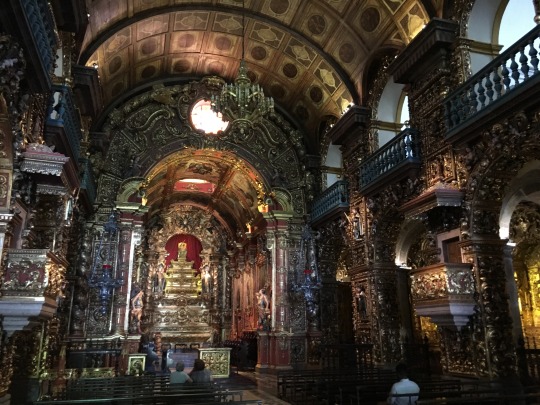
After a tasty chicken burger at the hip Cozinha Mironga I continued toward the waterfront to Igreja de Nossa Senhora Candelaria, the biggest of the city’s historic churches. The surrounding area houses lots of current and former government buildings, most of them imposing neoclassical edifices or fanciful Baroque colonial desserts (or both). I saw the Centro Cultural do Banco do Brasil (tho I skipped the current exhibition of Dreamworks art), Igreja de Nossa Senhora do Carmo da Antiga Se (which served royal functions when the Portguese throne decamped to Brazil) and Paco Imperial (the one-time royal palace). From there I walked through the extremely underwhelming (but historic) Arco de Teles into Travessa do Comercio, a charming cobblestone street of colonial townhouses, now home to outdoor cafes.
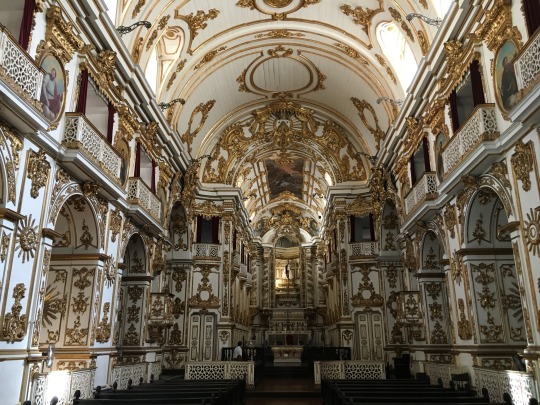
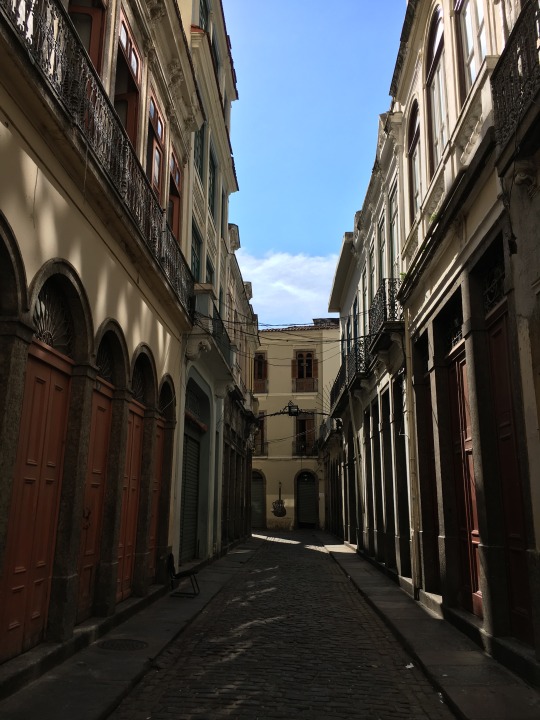
From here I cut across the hustling narrow streets of Centro to Largo da Carioca, a plaza surrounding by some atrocious 1960s skyscrapers (tho the Petrobras HQ is a marvel) and dominated by a very old church, Igreja Sao Francisco da Penitencia e Convento de Santo Antonio (phew). It’s beautifully restored and wins the gaudiest award in a very tough category. Not one inch of that chapel was left ungilded, an odd choice for an order who has taken a vow of poverty.


I then headed back up to Real Gabinete Portugues de Leitura, or the Royal Reading Room. It’s basically a library, and one of the most stunning I’ve ever seen. It’s three stories of books (over 350,000) in sumptuous but tasteful, muted decor. You can feel the knowledge surrounding you, and it makes you yearn to have more of it.
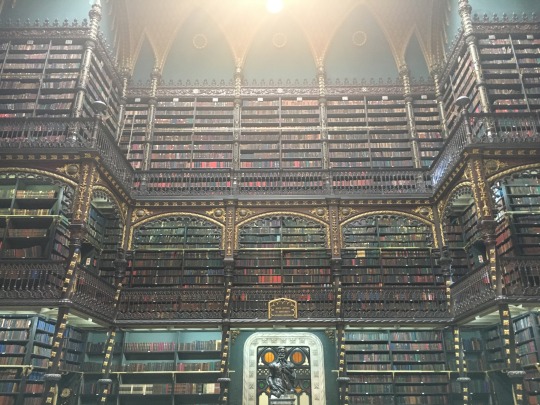
From there I veered west into Saara, a small grid of narrow streets that serves as an outdoor market and bazaar. You can probably find anything you need here and at a good price. At the end of it I found Campo de Santana, an elegant park with an odd assemblage of wild beasts-- cats, ducks, some sort of large fowl, and a cute, big rodent creature (capybara?). That was enough for one day so I headed back to Ipanema, had a big, tasty, cheap dinner at Frontera and went home to bed.
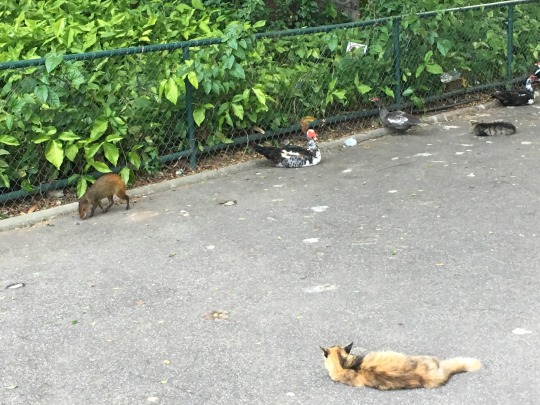
On Wednesday I headed back down to Centro to finish my tour. I started at the Museu Historico Nacional. I have a particular interest in history museums because a) I think it’s important to have some background and context when you travel; b) I’m a history nerd; and c) they are difficult to do well since good history requires a lot of text, which is not well-suited to a museum. Rio’s history museum is... decent. Housed in a well-maintained old fort, it could definitely use some refurbishing and some more engaging exhibits. After a respectable space telling the story of the indigenous people, it mostly focuses on the leaders and elites who steered the country from a Portuguese (and Dutch and French) colony into an independent republic. It has little to say about slaves, and I found no mention of the military dictatorship that ruled from the sixties to the eighties. (This is especially problematic given the current president’s favorable, revisionist view of the dictatorship.) But otherwise the narrative seems fair and accurate, if not thorough. It has almost no weighty artifacts, like original documents or “this was the actual thing that person used” items. It is mostly full of examples (of china, jewelry, slave shackles, etc.), paintings (many immense) and busts. Two awesome exceptions are a large array of carriages and early cars spanning three hundred years and an actual historic apothecary that was moved into the museum when it went out of business. I also appreciated that all of the displays had English translations tho they were riddled with errors. It made me wonder why the museum wouldn’t have them proofread before printing them up in a permanent exhibition.

From here I walked back to Praca Floriano (aka Cinelandia) which is the heart of downtown. The plaza is fairly non-descript, but it’s surrounded by some of the city’s most beautiful buildings: Theatro Municipal, Bibliolteca Nacional, Museu Nacional de Belas Artes and Camera Municipal. It was so stunning I stopped for lunch on the square and came back to see it lit up at night (when apparently the navy was attending the opera...).
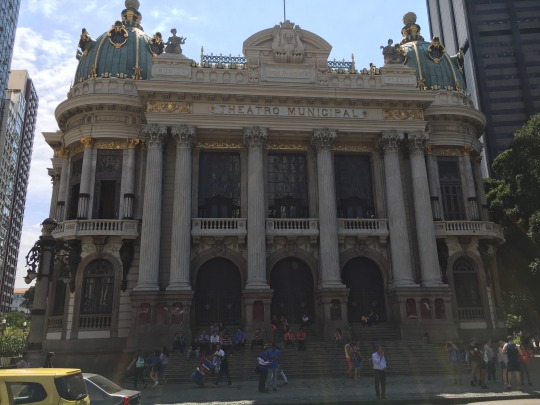
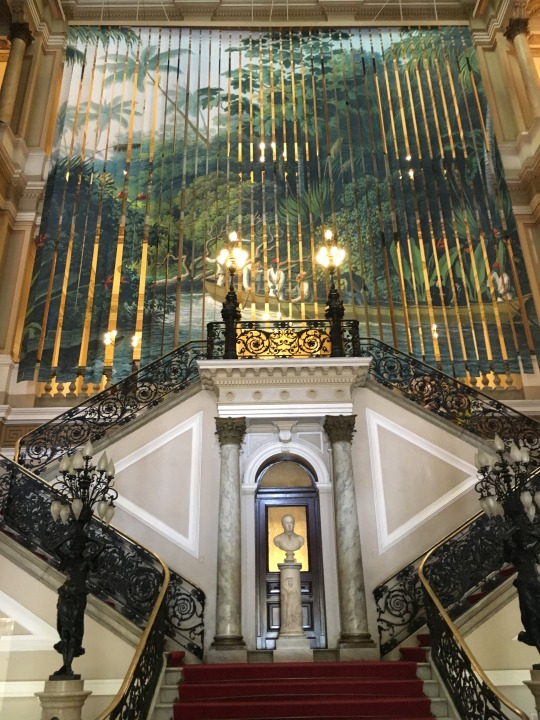


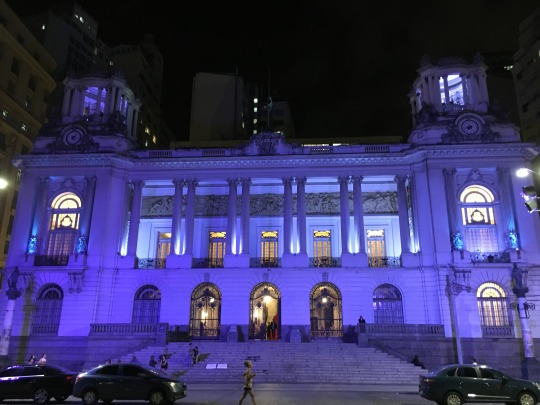
After lunch I continued west into Lapa, past the iconic Arcos (an old viaduct) and the peculiar Catedral Metropolitana de Sao Sebastio. It’s a brutalist cement cone modeled after Aztec pyramids, and it looks nothing like any church I’ve ever seen (tho not far off from St. Mary’s in San Francisco, aka “The Washing Machine”). After my initial shock and repulsion, I found it growing on me, if only for its boldness and break from tradition. It’s most famous for the tall stain-glassed windows (which are impressive in their size if not beauty), but what stood out to me was the main crucifix. It’s surprisingly small and suspended in the center of the cone about 30 feet above the altar. Jesus looks so vulnerable and alone, floating in an empty void. Of all the gory crucifixion scenes I’ve seen, this more than any other moved me and actually made me sad to think about Jesus’ plight.


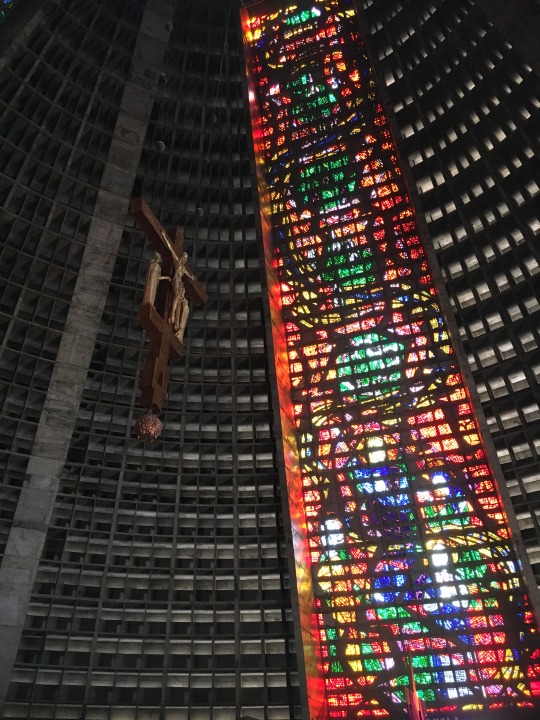
I then ventured further into Lapa. Nowadays it’s best known for its rowdy nightlife, and some of the bars were just starting to open up. Like much of Rio (and many Latin American cities), the area had traces of better days but now mostly looks decrepit. I made my way back, under the Arcos and headed to Cinelandia to catch the train home.
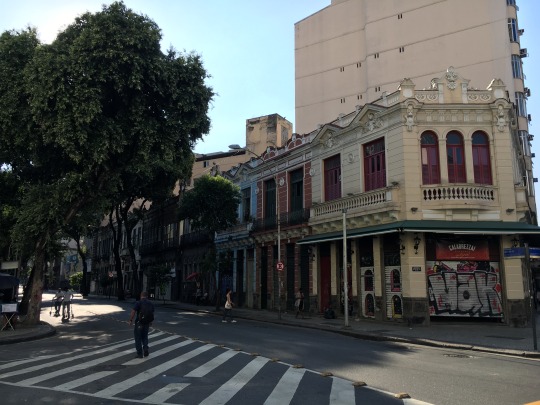
Thursday was considerably less ambitious. After a late start, I took the metro to Botafogo. Amid the usual urban grit of Rio are several beautiful old colonial mansions (as well as a notorious favela). I believe it was once an upscale artsy neighborhood that fell into decline, but some of the old buildings have been restored as museums or work spaces. Unfortunately, like so much of the city, they are hidden and inaccessible behind tall walls and fences. One beautiful exception is the Fundacao Casa de Rui Barbosa, once home to a famous writer and politician, now a museum. I didn’t go inside but the gorgeous grounds around the home are open to the public and look like a miniature botanical garden.

I made my way toward the next neighborhood, Humaita, and stopped at Cemiterio Sao Joao Batista, the final resting place for some of Brazil’s most famous residents. It’s quite beautiful and dramatic under the watchful eye of Christ the Redeemer. My last stop was Cobol do Humaita, a food market and dining hall, which are always pleasant to wander. The sun was going down so, after six days in Ipanema, I figured it was time to see the sunset on the beach. Obviously Rio faces East but the light is still nice.

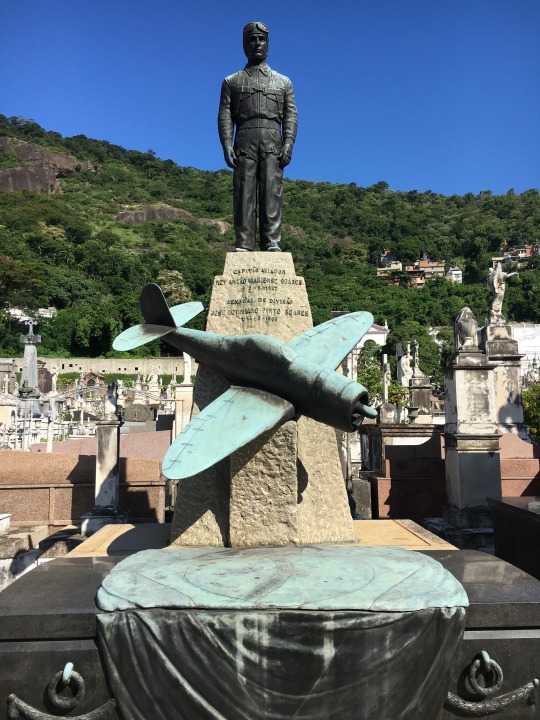

Friday turned out to be my most ambitious day and, painfully, the hottest so far. I returned to lovely Cinelandia and Lapa and visited the famous Escadaria Selaron, a public stairway that has been covered in a colorful tile mosaic in tribute to the people of Brazil. It’s pretty, fun and festive and swarming with tourists. Fortunately most people turn around at the top (if they get that far) instead of continuing into the beautiful Santa Teresa neighborhood. Like Botafogo, it’s full of charming old homes in various states of (dis)repair. But these are not walled off. And they run the gamut from cottages to palaces, so there is a lot of variety, both in architecture and culture. It reminded me of Russian Hill and Telegraph Hill. Also, this being a very steep hill, there are stunning views of the city and the bay from everywhere.

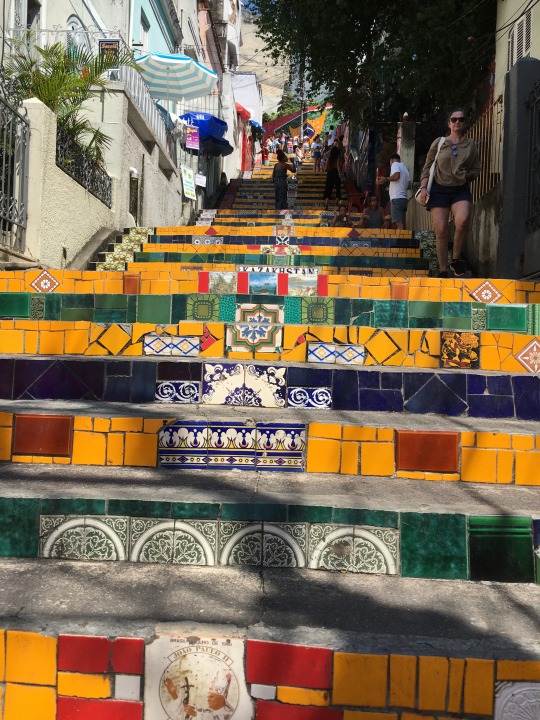
There is not much to do in Santa Teresa besides admire the loveliness, which probably helps keep the tourists away. Parque das Ruinas is the main attraction-- a crumbled mansion once owned by a salon-hosting socialite intellectual. It really feels like ruins, but staircases and walkways have been installed and the surrounding grounds turned into a park. The views from the top are spectacular. The small museum next door (Museu da Chacara do Ceu) hosts a private collection. It sounded interesting but appeared to be closed for construction.



I continued walking through the main commercial area which hosts some charming little boutiques, restaurants and bars (as well as a makeshift barber and a bar perched out on one of the viewpoints). I stopped for fantastic feijoada at Bar do Mineiro and more beer at the historic Bar do Gomes. Then, rather than walk all the way back down, I opted for the bonde, a cute little cable car that runs up and down the hill.
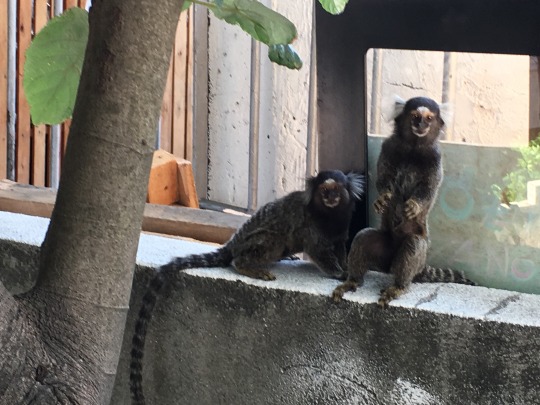


With a little daylight left, I headed back down to Botafogo and then over to Urca for one of Rio’s premiere attractions: Pao de Acucar (Sugarloaf Mountain). It stands tall at the north end of Copacabana and offers stunning views over the entire city and bay. It’s accessible by a sequence of two cable cars (gondolas), teetering at dizzying heights. It was crowded, as I expected at sunset, but not actually that bad. I stayed up there a while soaking in the “Marvelous City” and, like everyone else, taking tons of photos.



It was my first Friday night in the city, and I had nothing to do, which would have been a shame. But a guy I had been chatting with invited me to Paraiso do Tuiuti, a samba school. I demurred, concerned that I would not understand the instructions in Portuguese. But my friend then explained that it’s not a school so much as a club that performs sambas. The schools are formed in the favelas and compete at Carnaval every year. Friday night Paraiso was having a big birthday party and putting on a show for their friends.
The Paraiso clubhouse is across the street from Feira de Sao Cristovao, a kind of permanent country fair. It’s home to dozens of stalls selling all sorts of stuff, but at night, it’s mostly just restaurants and bars with a lot of karaoke. There is also a main stage with the kind of cheesy acts you would expect at a fair. And the crowd was overwhelmingly under 30, maybe 25. It was cute good times but I was not sorry to leave when my friend arrived.

The Paraiso do Tuiuti building is a big auditorium, not unlike a high school gym. A large samba band was in full swing in the corner of the mezzanine, and various people in uniforms, outfits and costumes were milling amongst the hundreds of guests. It all felt very festive, intimate and personable. A little later the performances started. My friend explained that each year at Carnaval each school performs a new samba and competes for first place (the schools are also organized like sports leagues with a top tier, mid tier, etc.). Paraiso do Tuiuti was performing their greatest hits that night in honor of their birthday (with songs going back to the 80s), and once they were done, a couple other schools-- Estacio de Sa and Mangueira (last year’s winners)-- performed as well. The whole experience was phenomenal and unforgettable-- the rhythms, the leg work, the costumes, the energy. It was a fantastic, only-in-Brazil night that a tourist can only hope to stumble upon.

Since I did not get home until 6am, Saturday and Sunday were my lazy days off before I returned to the tourist trail the next week....
1 note
·
View note
Text
Hybrids and chimeras: Mythology, history and science
Last week two papers were published about human and other chimeras, one in Cell on ‘Interspecies chimerism with mammalian pluripotent stem cells’ and one in Nature entitled ‘Interspecies organogenesis generates autologous functional islets’. The first one caused a bit of a stir in the newspapers. About 70 newspaper articles covered this potential scientific breakthrough in All English Language News (between 26 and 30 January, 2017). Many used the phrase ‘human-pig hybrid’. A small number evoked visions of ‘monsters’ (12) and, of course, Frankenstein – but the numbers were surprisingly small (2). Headlines talked about half-human, half-pig embryos echoing the earliest headlines on this issue which appeared in the 1990s, such as “Frankenstein half-human, half animal hybrids” (Daily Mail, January 12, 1993). The hope is that such hybrids might provide us with transplantable organs in the distant future; the fear it that they break down almost sacred boundaries between animals and humans.
More or less at the same time as these natural science papers were discussed in the press, Amy Hinterberger published an interesting social science paper on chimera regulation. The paper highlights how difficult regulation is in a context where clear boundaries unravel between humans and animals. The paper also mentions that thinking about human-animal hybrids and chimeras has a long history (p. 5). In this post I’ll try to explore that historical background a bit, as it informs current debates, perceptions and misconceptions.
Hybrids and chimeras
Before I do this, it is important to define and distinguish between hybrids and chimeras (or rather show how these concepts merge into each other). Below is a list of possible types of animal/human hybrid embryos provided by the BBC in 2014 (more detailed information about definitions can be found in this 2011 report by the Academy of Medical Sciences). It seems that ‘hybrid’ is the general term covering different types of human/non-human mixtures:
Cytoplasmic hybrid embryos: embryos created through cell nuclear replacement using animal eggs
Hybrid embryos: embryos created by mixing human sperm and animal eggs or human eggs and animal spermHuman chimera embryos: human embryos which have animal cells added to them during early development
Animal chimera embryos: animal embryos which have human cells added to them during early development – these are the ones that created a stir just now
Transgenic human embryos: human embryos which have animal genes inserted into them during early development
Scientific research around human-animal hybrids and chimeras has a long history. It reached a high-point around 2004/2005 when “the British government launched a public consultation in advance of proposed changes to the 1990 Human Fertilisation and Embryology Act. Responses were published in March 2006.” (BioCentre)
Now, a decade later, discussions seem to be starting up again. Although I haven’t done any extensive research into the matter, some of the media hype and rhetoric used now seems to mirror that of a decade ago – but is more attenuated.
Before we talk about hybrids again it might be good to get a better grip, not only on the science of hybrids and chimeras, but also on the history of these concepts, as that impacts on how we think and talk about them.
Hybrids in history
The concept of hybridity is an ancient one. Deriving from the Latin hybrida, it was first used to describe the offspring of a tame sow and wild boar, and was also used to describe Roman soldiers of mixed descent (Horace, Satires 1.7). Its usage in English dates as far back as 1601 when Philemon Holland, in his translation of Pliny the Elder, described how “[t]here is no creature ingenders so soon with wild of the kind, as doth swine; and verily such hogs in old time they called Hybrides, as a man would say, halfe wild” (Pliny II: 231) (see www.oed.com for a full list of spellings, etymology, quotations and dates).
Artistic depictions of ‘hybrids’ are as old as humanity. “[C]omposite beings, from a world between humans and animals, are a common theme from the beginning of painting”. In the Middle Ages hybrids litter the margins of illuminated manuscripts; they “occupy a liminal space where the sacred meets the secular and profane”. Follow Damien Kempf on Twitter if you want to see some of them!
Hybrids have always formed an integral part of myths, legend and speculation: Ovid describes the fluid interchange of divine, human and animal bodies in his Metamorphoses, and in Greek mythology fantastic creatures are typically depicted as hybrids or monsters, such as the Minotaur (man and bull), the centaur (man and horse) and the chimera (lion, goat and snake), to name but a few. The chimera, in turn, was a fire-breathing female monster with a lion’s head, a goat’s body, and a serpent’s tail.
I’ll now jump forward in time! But before I do so I want to quote the lead author of the paper in Cell who makes a direct link between modern research and mythology: “for lead study author Jun Wu of the Salk Institute, we need only look to mythical chimeras—like the human-bird hybrids we know as angels—for a different perspective. ‘In ancient civilizations, chimeras were associated with God,’ he says, and our ancestors thought ‘the chimeric form can guard humans.’ In a sense, that’s what the team hopes human-animal hybrids will one day do.” (National Geographic) And, of course, this type of framing might guard against a Frankensteinian back-lash and science.
Hybrids in science
By the late 18th century hybridity had come to be used to describe the offspring of two animals or plants of any different species, and it began to play a small role in scientific reflection.
In the 18th and early 19th centuries, hybrids were still widely considered to be violations of nature, and most held the view that all species had been created by God and were “fixed within limits beyond which they cannot change”. Carl Linnaeus (the ‘father’ of plant taxonomy) advanced the idea that some species might begin as hybrids, and he updated the special creationist view he held in 1737 in his Philosophia botanica to account for natural hybrids. For many, Linnaeus’s theory was an assault on the idea of a natural order. Several botanists attempted to reconcile the existence of hybrids with their belief in the fixity of species by demonstrating an essential difference between hybrids and true species (Olby, 1966).
The German botanists Joseph Gottlieb Kölreuter and Karl Friedrich von Gärtner devoted almost their entire lives to the subject of plant hybrids, and while they attempted to find a set of pre-Darwinian evolutionary proofs for their existence, they disputed the modified theory of special creation by qualifying their reproductive stability (Callender, 1988).
In the 19th century the hybrid began to be discussed in scientific debates surrounding the nature of evolution. In a chapter entitled ‘hybridism’ in On the Origin of Species, Charles Darwin attempted to evaluate the evolutionary significance of hybrids, and to expose the essential difference between species and varieties as arbitrary (Darwin, 1859: Chapter IX). Darwin revolutionised evolutionary thought by refusing to take the line of botanists such as Gärtner, “whose strong wish it was to draw a distinct line between species and varieties”.
In 1866 Gregor Mendel published a paper on plant hybridisation, “Experiments on Plant Hybrids”, that drew on several of Darwin’s ideas, but despite his commitment to a pre-Darwinian view of evolution Mendel never reached a point where he could make a definite conclusion about the role of hybrids in the origin of species (Clegg, 1997).
The term ‘chimera’ also has a long history, but I only want to point out that it was first used in a scientific sense (German ‘Chimäre’; graft hybrid) in 1907 by Hans Winkler in the context of plant breeding. The OED provides the following definition of this type of chimera: “An organism (commonly a plant) in which tissues of genetically different constitution co-exist as a result of grafting, mutation, or some other process.”
Hybrids and the new genetics
The most recent phase in the development of the concept of hybridity happened in context of the emergence of genetic engineering. A key difference between hybrids today and their 18th– and 19th-century counterparts is that in modern discourse they are perceived as being ‘designed’, ‘made’ or ‘manufactured’ artificially rather than produced ‘organically’ through the ‘natural’ process of selective breeding or grafting. Scientists today can create hybrids, chimeras and transgenic creatures beyond the wildest dreams of Gärtner, Darwin, Mendel or Winzer. Moreover, where the experiments of the traditional botanists were laborious and time-consuming, now geneticists can theoretically create hybrids and chimeras almost instantaneously using CRISPR for example.
Shortly after the creation (cloning) of Dolly the sheep and the media sensation it became, in 1998, the hybrid became the primary focus of a leading newspaper article, published on April 5 by The Independent under the headline “Duo bids to halt breeding of human-animal hybrids”. The article culminated with a quote from Thomas Murray, director of the Center for Biomedical Ethics at Case Western Reserve University: “If we put one human gene in an animal, or two or three, some people may get nervous but you’re clearly not making a person yet. But when you talk about a hefty percentage of the cells being human . . . this really is problematic. Then you have to ask these very hard questions about what it means to be human.”
These are the questions that would trouble the experts, lay people and the media throughout the years to come. Where do you draw the line between animal and human? At what point in the process of hybridisation should we become anxious that a moral boundary is being crossed and when it is time to turn back?
To close this rather long post, I want go back to history, this time literature, to show that debates about the creation of hybrids and chimeras have been with us for a long time and will be with us even longer. As the authors of the article quoted at the beginning of this post have admitted themselves, actual human-animal hybrids that can be used for organ donation are still very very far away.
Discussing hybrids – a long tradition
When debating the merits (and hype) of creating human-animal hybrids or chimeras, people often refer to Mary Shelley’s Frankenstein (1818) or H. G. Wells’ The Island of Doctor Moreau (1896). Both evoke the spectre of ‘monsters’ (a Mirror headline in 2016 declared: “Frankenstein scientists developing part-human part-animal ‘chimera’ embryos which could treat diseases”; LifeNews.com heralded this January’s study as: “Scientists create human-pig hybrids for organ transplants that could develop into ‘monsters’).
However, there is a passage in William Shakespeare’s The Winter’s Tale (1623) (act 4, scene 4) that is much less frequently quoted, but should perhaps be, as it provides a more ‘balanced’ discussion of hybrids:
Perdita
Sir, the year growing ancient,
Not yet on summer’s death, nor on the birth
Of trembling winter, the fairest
flowers o’ the season
Are our carnations and streak’d gillyvors,
Which some call nature’s bastards: of that kind
Our rustic garden’s barren; and I care not
To get slips of them.
Polixenes
Wherefore, gentle maiden,
Do you neglect them?
Perdita
For I have heard it said
There is an art which in their piedness shares
With great creating nature.
Polixenes
Say there be;
Yet nature is made better by no mean
But nature makes that mean: so, over that art
Which you say adds to nature, is an art
That nature makes. You see, sweet maid, we marry
A gentler scion to the wildest stock,
And make conceive a bark of baser kind
By bud of nobler race: this is an art
Which does mend nature, change it rather, but
The art itself is nature.
Perdita
So it is.
Polixenes
Then make your garden rich in gillyvors,
And do not call them bastards.
Perdita
I’ll not put
The dibble in earth to set one slip of them….
This dialogue encapsulates positions on the issue of genetic engineering and hybrids/chimeras with which we are still grappling. On the one hand we have Polixenes who defends and celebrates the manipulation of nature; on the other we have Perdita who condemns hybrid plants as impure ‘bastards’. Interestingly, in this exchange, the argument for hybrids is given equal, if not more weighting than the argument against.
It will be interesting to see how the debate about human-animal hybrids and chimeras unfolds in the future against the deep historical background of art, mythology, literature and science that I have tried to outline in this post – and I have only scratched the surface.
Image: Harpyie, circa 1360, Jacob van Maerlan
The post Hybrids and chimeras: Mythology, history and science appeared first on Making Science Public.
via Making Science Public http://ift.tt/2l3oR4P
0 notes